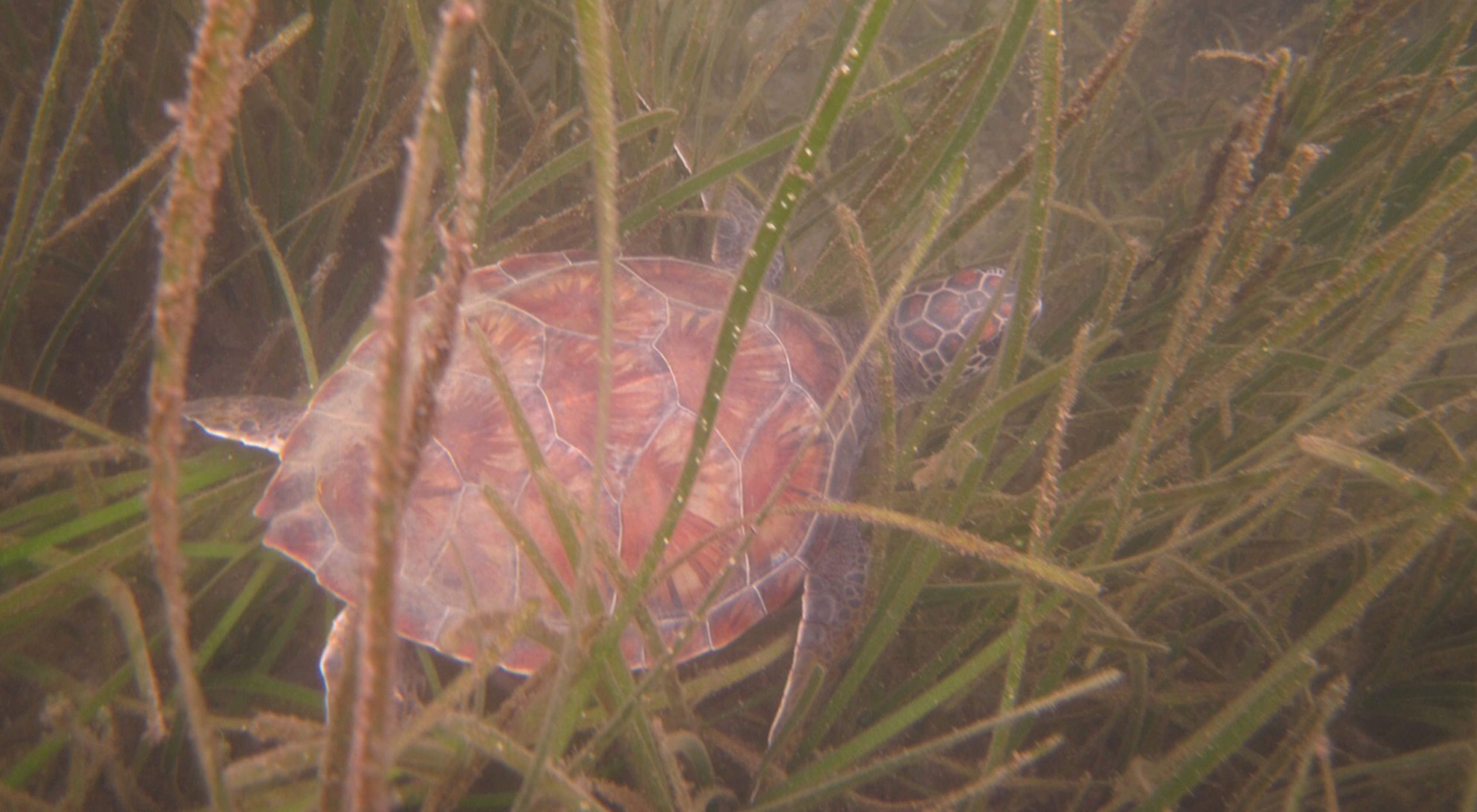Protecting Seagrass in Long Island Sound
We know why a critical habitat is in decline; now we’re trying to save it.
A diver off Fishers Island—a roughly 4-square-mile island off the eastern end of New York’s Long Island—can encounter a mesmerizing sight: hundreds of tiny, silver-sided fish shimmering in the sunlight as a juvenile green sea turtle glides above a lush meadow of tall, waving grass blades.
“These seagrass meadows are extraordinary,” says Chantal Collier, director of The Nature Conservancy’s Long Island Sound program. “They also represent something rare.”
Exceptional in Long Island Sound for its height of up to 3 feet and the 24-foot depths to which it grows, Fishers Island’s seagrass is also among the last meadows remaining in the Sound.
Seagrass meadows once fringed bays and harbors along both New York and Connecticut’s shores, but today 90 percent of the seagrass is gone. The Conservancy has completed extensive research into the decline of these meadows, which provide irreplaceable benefits for marine life and people. And, now we’re working to ensure the Sound’s remaining meadows are protected and to restore the conditions seagrass needs to thrive.
“We have only about 2,000 acres – about 10 percent – left in the Sound, so the first priority is to protect what we still have,” Collier says.
Why Seagrass Matters and What Happened to It
Seagrasses are a unique group of flowering marine plants that live fully submerged in shallow coastal waters around the world and provide essential habitat for thousands of ocean animals.
Eelgrass (Zostera marina), the main species of seagrass found in Long Island Sound, provides habitat for species, such as flounder, bay scallops and American lobster, that are commercially and recreationally important.
Seagrass meadows also provide recreational opportunities for divers, improve water quality and clarity by absorbing nutrients, and reduce shoreline erosion by stabilizing sediments. Additionally, they help mitigate climate change and its impacts by sequestering carbon.
“Seagrasses are an important component of what’s called ‘blue carbon,’ which is carbon stored in aquatic systems, primarily mangroves, saltmarsh and seagrass meadows,” Collier says.
Some of the “services” seagrass provides hint at its vulnerabilities, too, though.
In 2009, the Conservancy embarked on a multiyear, federally funded research initiative to better understand the causes of seagrass decline throughout the waters of Southern New England and New York. The initiative, completed in 2014, identified nitrogen pollution—primarily from sewage and fertilizers—and warmer water temperatures as the greatest threats to seagrass populations throughout the study region.
For example: Although seagrass can absorb nitrogen, too much nitrogen can fuel overgrowth of harmful algae that smothers it. Likewise, while seagrass—particularly in established meadows with deep root systems—absorbs and retains carbon, seagrass that is vulnerable to degradation by warming seas is at risk of becoming a source of carbon emissions.
Also, Collier says, while we know seagrass was hit hard by disease in the 1930s, today there are persistent threats associated with physical damage from activities such as anchoring, moorings, propeller scars, dredging, coastal construction and some types of fishing gear.
With this knowledge, the Conservancy is turning toward protecting the seagrass that remains and restoring water quality where meadows have been lost.
This brings us back to Fishers Island.
Protecting Seagrass: What Comes Now?
After completing research on the causes of seagrass decline, Conservancy scientists first shared what they learned widely with conservation partners and others with a stake in the Sound’s health.
Now, they’re integrating those results with findings from a study Collier conducted at Duke University’s Nicholas School of the Environment and applying them to seagrass management.
“My research focused on understanding the Fishers Island community’s perceptions and values associated with local marine resources and their hopes and concerns regarding the opportunity to protect those resources through New York’s Seagrass Protection Act,” Collier says.
The 2012 law calls for the state to work in consultation with local communities and stakeholders to designate seagrass management areas and create management plans for those areas.
To help with this, Collier is working with the Fishers Island Conservancy, the Henry L. Ferguson Museum, other island community members and state representatives to develop collaborative seagrass management options.
“Fishers Island has an incredible natural resource in its seagrass meadows,” Collier says. “Fortunately, the island’s residents also care deeply about protecting the island and share a history of resource conservation and stewardship.”
The Long Island Sound includes both Connecticut and New York waters, and Conservancy seagrass efforts extend across state borders, too.
“The Blue Plan process is important for the entire Sound,” Collier says, referring to the development of a Long Island Sound Blue Plan, which the Conservancy has championed and Connecticut lawmakers initiated in 2015 to balance future uses with protection of the Sound.
A key component of the Blue Plan is to identify the locations of sensitive habitats. The Conservancy incorporated seagrass habitat into its 2015 Long Island Sound Ecological Assessment, which is now being used as one of the data sets for the Blue Plan.
Collier is also part of a 23-person stakeholder team exploring potential sites for a National Estuarine Research Reserve in Connecticut waters.
These reserves don’t involve creating new regulations or restrictions; instead they are geared toward expanding community awareness and understanding of marine environments and supporting research to inform marine management.
Says Collier: “Regardless of where its sited, a National Estuarine Research Reserve will help bring attention to the importance of protecting and managing or restoring seagrass, as well as all the other habitats in the Connecticut waters of the Sound.”
Keeping Our Promise to Fishers Island
Your support helps us continue to preserve and protect seagrass in Long Island Sound.
